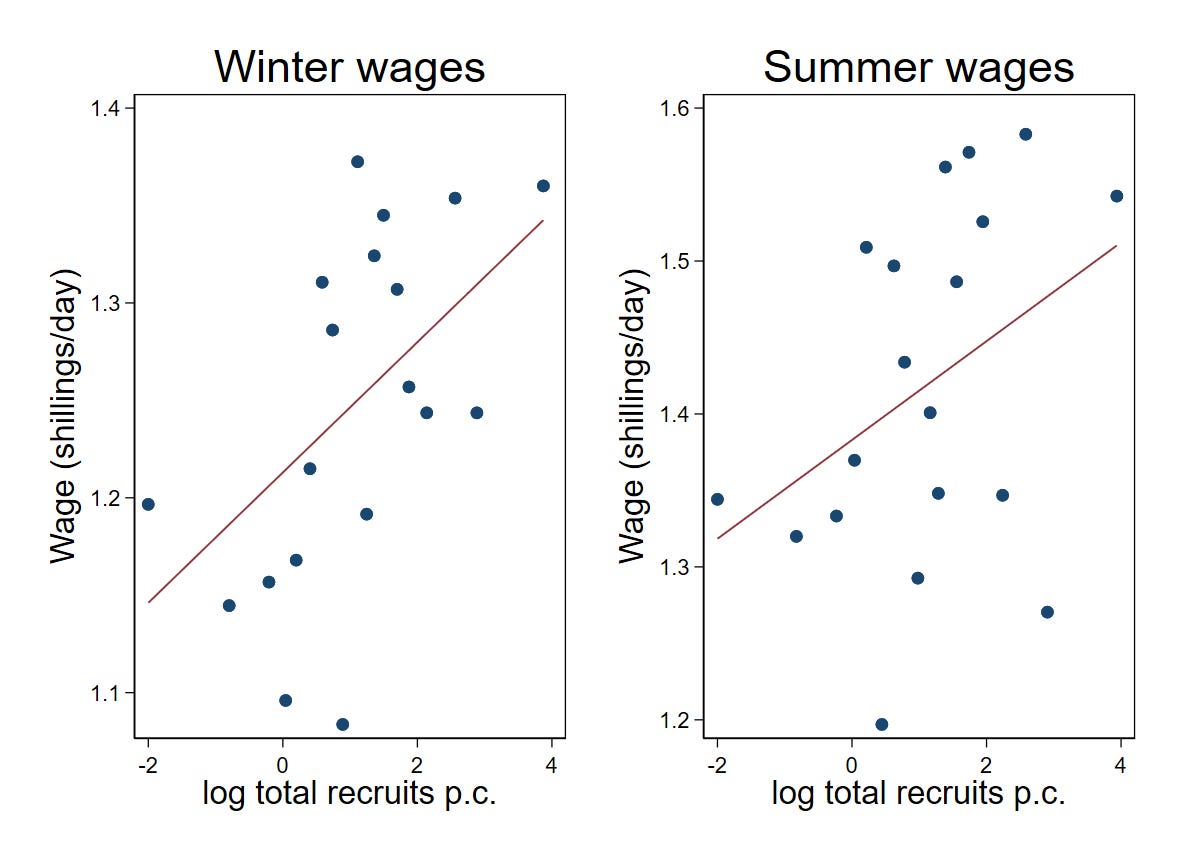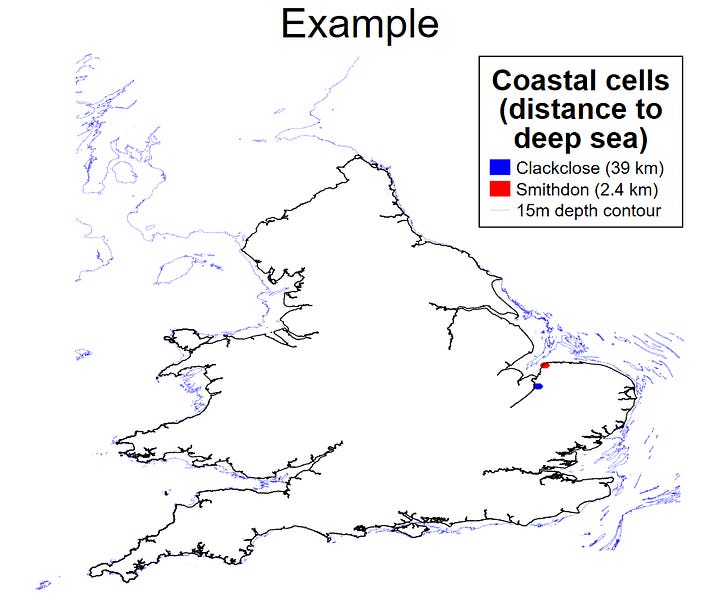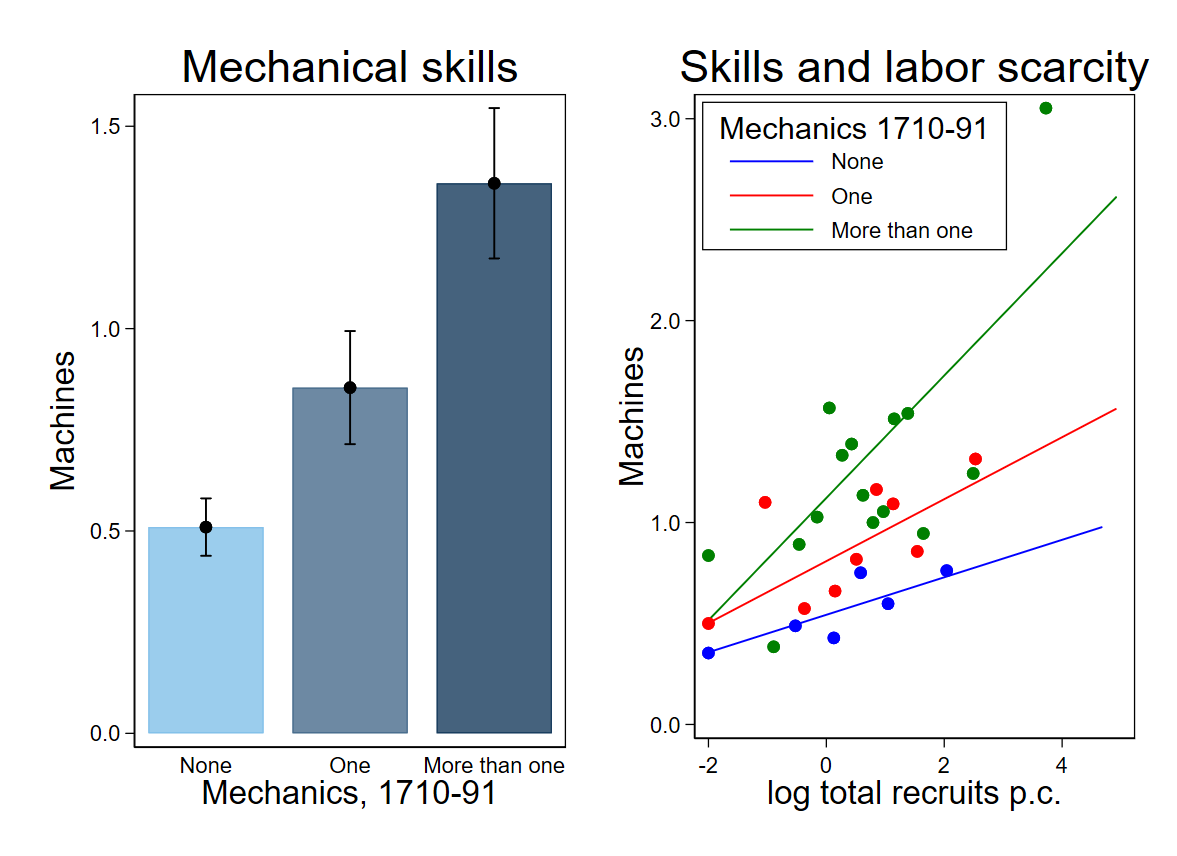Where have all the workers gone? War and technological progress during the Industrial Revolution
by Bruno Caprettini
Between 1792 and 1815 war raged across land and sea. During that quarter-century, Revolutionary and Napoleonic France fought on five continents in what was arguably the first truly global conflict. At the center of the shifting alliances opposing France stood Britain, which fought French expansion with blood and treasure. The sacrifice paid off: when Napoleon surrendered at Waterloo, Britain emerged as the great power of the century.
As important as the war was to cement British global dominance, its most profound effect may have been subtler. Over those twenty-three years, hundreds of thousands of British men left to fight Napoleon, creating acute labor shortages at home. British entrepreneurs responded to these shortages with new, labor-saving machines, accelerating technological progress and growth (cf. Acemoglu 2002). In short, the men of Wellington and Nelson made Britain great—not only in the ways they imagined.
Why it matters – the debate on the Industrial Revolution
The idea that labor scarcity spurred technological progress during the Industrial Revolution is not new. Allen (2009) argued that Britain’s relative factor prices made the Industrial Revolution economically viable: British coal was abundant and cheap, while British labor scarce and dear. It made sense then for British entrepreneurs to introduce machines that used lots of coal but little labor.
While intuitive, the theory has not gone unchallenged. Mokyr (2021) has suggested that high wages reflected the exceptional productivity of British workers, and that—by international standards—British labor was in fact not expensive in real terms. Along with Kelly and Ó Grada (2023), he further argues that what really set Britain apart was the quality of its workforce, as the country was unusually rich in skilled mechanics who developed and maintained new, complex machines.
Adjudicating between these competing views is hard: only one country industrialized first, and comparing Britain to its contemporaries hardly leads to credible quantitative analysis.
Taking the grand theories to the micro-data
In “Fighting for Growth” (2024), Joachim Voth, Alex Trew and I set out to test these grand theories of the Industrial Revolution. Rather than comparing countries, we ask whether local supply of labor and skill can explain the different pace of technological progress within Britain. Our focus is the period of the wars against France, when military recruitment pulled vast numbers of men from the civilian labor force. In 1809, the army and militia numbered 300’000 men, with another 141’000 serving aboard Royal Navy ships (Rodger 2004). Together they accounted for nearly 15 percent of England and Wales male, prime-age population of 1811. To put that in perspective, Napoleon’s Grand Armée, relative to France’s population, was only about one-third as large. Importantly, British recruitment was highly uneven: some regions sent many more men than others (Figure 1). With low labor mobility (Smith 1776), these localized shocks created substantial regional variation in labor costs.


We find clear evidence of a tightening labor market in areas with high recruitment, both in primary sources and in historical data. Writing from Yorkshire, Tuke (1800) observed: “an advance from twenty to twenty-five per cent has generally taken place [in wages], arising […] from the great consumption of men in the navy and army, and consequent present extreme scarcity of hands for agricultural labour.” The situation was similar in Hereford, where “the population is so much thinned by the levies and operations of war, that the farmer in particular, has but little opportunity of selection” (Duncumb 1805). Systematic analysis of wage data—collected from over 20,000 pages of Parliamentary reports—confirms a strong positive association between recruitment and wages in both summer and winter (Figure 2). In some regions, rising labor costs were large enough to push entrepreneurs to experiment with labor-saving technologies.

Technology in the fields
We study how new technology spread through British agriculture. This focus is useful for two reasons. First, agriculture became one of the most dynamic sectors of the economy during these years, adopting machines—like mechanical threshers—that had existed for decades but had failed to gain traction. Second, unlike manufacturing which was geographically concentrated, farmers cultivated almost every corner of England. Thus, a study of agricultural technology can exploit the full geographic variation in recruitment and provide evidence that war-induced labor shortages stimulated technology adoption.
The link between war, labor shortages and technology adoption was clear to contemporaries and visible in the data. Writing from the South of England, Stevenson (1812) noted that “[a] considerable number of thrashing [sic] machines have been erected in this county […] the principal inducement for using them is a scarcity of labourers, which, in a state of warfare, may be expected to be felt most in the maritime districts.” To move beyond anecdotes, we collected detailed data from historical newspapers advertising farm sales and leases. We read more than 20’000 such articles, and whenever one mentioned a labor-saving machine, we geolocated it and added it to our data. The left panel of Figure 3 shows where these machines appeared, while the right one documents a strong, positive association between recruitment and adoption. This evidence provides initial support to the idea that wartime labor scarcity pushed farmers to substitute workers with machines—but is the relationship causal?


Did recruitment cause technology adoption?
Correlation is not causation, and recruitment may rise and fall with adoption without causing it. For one, labor-replacing machines might have displaced rural workers, worsening their employment opportunities and encouraging them to enlist. In other words, causation may run in the opposite direction, from adoption to recruitment. Additionally, a third factor—such as proximity to urban centers—might drive both higher recruitment and faster adoption by easing access to new ideas and potential recruits. In short, granular data alone cannot establish causality.
To make progress, we focus on naval recruitment, which was both massive and constrained by natural factors. Royal Navy wartime demand for men reached beyond experienced seafarers: during the Napoleonic Wars the Navy faced what Dancy (2015) calls a “problem of arithmetic,” as Britain lacked enough seamen to crew its thousand ships. To fill the gap, the Navy recruited hundreds of thousands of inexperienced “landsmen:” according to our back-of-the-napkin math, the number may have reached 280’000. But naval recruitment is compelling not only because of its scale: it was also determined by external constraints that provide a plausible instrument for identifying causal effects.
The reach of the Royal Navy
We identify the causal effect of recruitment using variation in coastal access. In the 18th century, every Royal Navy captain was responsible for raising his crew from British coastal towns. Whether captains could visit a town depended however on the seabed offshore: the Navy’s largest ships rose high above the waterline to accommodate three decks of cannons, and they needed as much water underneath for the keels that kept them stable. While this may suggest exploiting access to deep sea as an instrument for naval recruitment, proximity to deep sea also correlates with distance to the coast, and being close to the coast may directly affect the local labor market. To isolate quasi-random variation in naval recruitment, we thus focus on a narrow strip of land within 15 km of the British shoreline and use distance to deep sea as our instrument (Figure 4, left). Within this coastal sample, distance to the deep sea is unrelated with many local characteristics, including the presence of commercial (i.e. non-naval) ports. In short, within the coastal sample, distance to the deep sea appears as good as randomly assigned, and it qualifies as a valid instrument for Royal Navy recruitment.


To illustrate the logic of our instrumental variable strategy, consider two ancient hundreds in Norfolk: Clackclose and Smithdon (Figure 4, right). Both lie on fertile coastal land near the mouth of the Great Ouse: just 32 km separate them. In 1801-11, they were home to around 1’000 people each—mostly rural workers—and were similar along all observable characteristics. All except one: Smithdon faces the deep sea of East Anglia while Clackclose lies on shallow waters of the Great Ouse estuary, 16 times as far from the deep sea (2.4 vs 39 km). The Royal Navy recruited in Smithdon but not in Clockclose, resulting in greater gender imbalances (1.05 vs 1 women per men) as well as in faster technology adoption: we find twice as many labor saving machines in Smithdon (14 vs 7).
Our instrumental variable strategy generalizes this logic across the entire coastal sample. We find that areas with deep sea access experienced more naval recruitment and faster technology adoption: a doubling of recruitment led to one extra machine. Since seabed depth is plausibly unrelated to local labor market dynamics in otherwise similar coastal areas, the link between recruitment, labor scarcity, and adoption is likely causal.
The role of skilled labor
Was labor scarcity all that Britain needed to take off? Machines could replace the men fighting Napoleon—but they still had to be built and maintained. Kelly, Ó Grada & Mokyr (2023) argue that Britain had an unusually large supply of expert mechanics with the skills needed to assemble and service these machines. To measure the role of these expert mechanics, we look at the years leading to the Napoleonic Wars and count how many young men apprenticed to become millwrights, wheelwrights and watchmakers. These apprentices learnt mechanical skills essential to build the complex machines we study: their presence, in theory, should facilitate technology adoption. This is what we find: areas with at least one mechanic adopted significantly more than those without (Figure 5, left). More strikingly, these mechanics also magnified the impact of recruitment on adoption (Figure 5, right): in areas with skilled mechanics, labor scarcity led to much more adoption than areas without it. In sum, labor scarcity and skill abundance both promoted technological progress – indeed, they reinforced each other.

The first industrial country
Why did England industrialize? It is a mistake to believe that a single factor can account for Britain’s take-off (Koyama & Rubin 2022). Our work provides support to the two most prominent theories of the Industrial Revolution and shows that labor scarcity and skill abundance complemented each other in promoting technology diffusion. Naturally, technological progress started earlier than 1800 and was fastest in manufacturing sectors such as textiles. However, the forces we identify were at play throughout the 18th century, when Britain fought a war one year every three. Technological progress during the labor shortages of the Napoleonic Wars may thus explain why the country that fought the most, was also the country that industrialized first.
References
Acemoglu, D. (2002). Directed technical change. The review of economic studies, 69(4), 781-809.
Allen, R. C. (2009). The British industrial revolution in global perspective. Cambridge University Press.
Dancy, J. R. (2015). The myth of the press gang: volunteers, impressment and the naval manpower problem in the late eighteenth century. Boydell & Brewer Ltd.
Duncumb, J. (1805). General View of the Agriculture of the County of Hereford. London Phillips.
EMODnet (2018). EMODnet Digital Bathymetry (DTM 2018).
Kelly, M., Mokyr, J., & Ó Gráda, C. (2023). The mechanics of the Industrial Revolution. Journal of Political Economy, 131(1), 59-94.
Koyama, M., & Rubin, J. (2022). How the world became rich: The historical origins of economic growth. John Wiley & Sons.
Mokyr, J. (2021). The holy land of industrialism: Rethinking the Industrial Revolution. Journal of the British Academy, 9, 223-47.
Rodger, N. A. M. (2004). The command of the ocean: A naval history of Britain, 1649–1815. Penguin Books.
Smith, A. (1776). An inquiry into the nature and causes of the wealth of nations. W. Strahan and T. Cadell.
Stevenson, W. (1812). General View of the Agriculture of the County of Dorset. London McMillan.
Tuke, J. (1800). General View of the Agriculture of the North Riding of Yorkshire. London McMillan.
Voth, H. J., Caprettini, B., & Trew, A. (2024). Fighting for growth: Labor scarcity and technological progress during the British industrial revolution. CEPR Discussion Papers, (17881).
Bruno Caprettini is Assistant Professor at the University of St Gallen (Switzerland). He studies long-term growth and political economy, with a particular focus on the Industrial Revolution. He holds a PhD from Universitat Pompeu Fabra (Barcelona).


